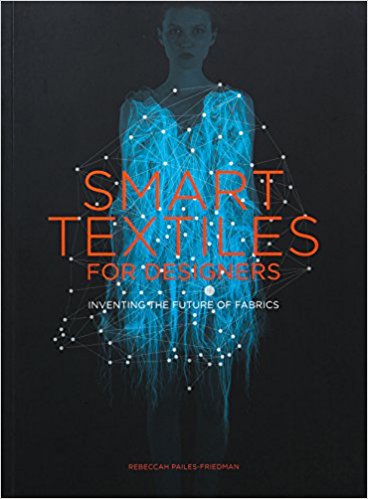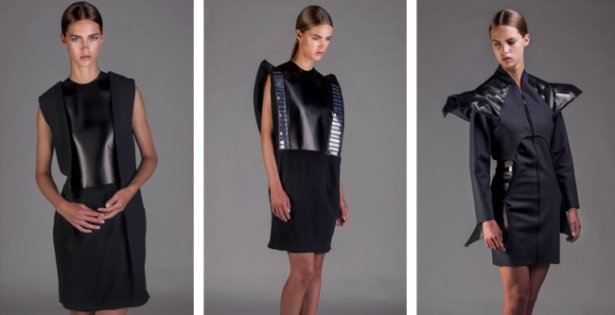This post comes from the Artists and Climate Change Blog
We begin the second year of our monthly series Renewable Energy Artworks by introducing a new topic on this blog: textile artists and fashion designers experimenting with so-called “smart textiles†that can harvest and store renewable energy. Throughout 2018, we will occasionally post profiles of textile artists at the forefront of this revolution: the convergence of textiles and distributed energy technology. We start today with a brief introduction to the Dutch fashion designer Pauline van Dongen, founder of Wearable Solar.
______________________________
In case you missed it – solar photovoltaic (PV) technology is evolving so fast that scientists in South Korea recently created ultra-thin flexible solar cells, as thin as a human hair.
Could this be the Holy Grail for textile artists? Imagine being able to weave energy-harvesting solar nanothreads into the textiles we use on a daily basis: clothing, bed linen, furniture upholstery, window shades and curtains, sports and camping gear. Not to mention refugee shelters and protective garments for first responders, astronauts, and the military.
The challenge, however, is to move this promising technology beyond the laboratory to the commercial market. As Aimee Rose, chief technology officer at the Advanced Functional Fabrics of America, explained in a 2016 Business of Fashion interview: “We’ve demonstrated we can create a fibre that stores energy and can act as a battery – but how do we get that into clothing?â€
Smart textiles (sometimes called e-textiles) are much more than just the integration of electronics into garments. They include any textile with the ability to interact with its surrounding environment and react to changes in that environment.
According to Rebeccah Pailes-Friedman in her 2016 book, Smart Textiles for Designers, smart textiles “will challenge your idea of what fabrics and textiles are, and inspire you to rethink what your clothing and other products made with textiles can do.â€

For those not familiar with this topic, the following panel discussion about Fashion’s Fourth Industrial Revolution provides an excellent introduction. Bookmark it for the weekend (it’s 53 minutes).
In general, we can say that, to date, there are three generations of smart textiles:
- garments that hold the sensor in place
- garments in which the sensor is embedded/integrated into the fabric
- garments that act as the sensor itself
For this series, I am mainly interested in second generation garments that can harvest solar energy. These include smart textiles that contain electrically conductive yarns, fibres and/or metals that are woven, embroidered, knitted, 3D-printed or embedded into the fabric in order to capture solar or mechanical energy and convert it into clean electricity to charge our mobile devices (or to store that electricity for later use).
The Dutch fashion innovator Pauline van Dongen is at the forefront of this textile revolution, collaborating across multiple technical disciplines to create clothes of the future. She was recently named a laureate in the 35 Innovators Under 35 Europe in 2017.
To date, van Dongen’s Wearable Solar collection includes four items: solar windbreaker, solar parka, solar dress and solar shirt. Although none of these items is ready for the commercial market, van Dongen is committed to advancing the technology to improve production, affordability and long-term use, including repeated washing.

I will write more about Pauline van Dongen in a future post.
In October 2017, Levi Strauss released its long awaited Commuter Trucker Jacket in collaboration with Google. This “connected†jacket has Google’s Project Jacquard technology woven into the denim which essentially turns the jacket into an extension of the user’s mobile phone. While this jacket does not convert solar energy into electricity, I could not resist including mention of it in this space, since it is an example of the first commercially available connected clothing (despite lukewarm reviews).
The video below is visually stunning, and gives a sense of how tantalizingly close we are to this brave new world of textile connectedness.
A headline in a 2016 article in digitaltrends.com says it all: Today we carry technology. Tomorrow we’ll wear it.
(Top photo: Video grab shot from YouTube video https://www.youtube.com/watch?v=qObSFfdfe7I&feature=youtu.be)
______________________________
Joan Sullivan is a renewable energy photographer based in Québec, Canada. Since 2009, Joan has focused her cameras (and more recently her drones) exclusively on solutions to climate change. She is convinced that the inevitable transition to a 100% clean energy economy will happen faster – and within our lifetimes – by creating positive images and stories that help us visualize and embrace what a post-carbon future will look like. Joan collaborates frequently with filmmakers on documentary films that explore the human side of the energy transition. She is currently working on a photo book about the energy transition. Her renewable energy photos have been exhibited in group shows in Canada and the UK. You can find Joan onTwitter and Instagram.Â
Artists and Climate Change is a blog that tracks artistic responses from all disciplines to the problem of climate change. It is both a study about what is being done, and a resource for anyone interested in the subject. Art has the power to reframe the conversation about our environmental crisis so it is inclusive, constructive, and conducive to action. Art can, and should, shape our values and behavior so we are better equipped to face the formidable challenge in front of us.


